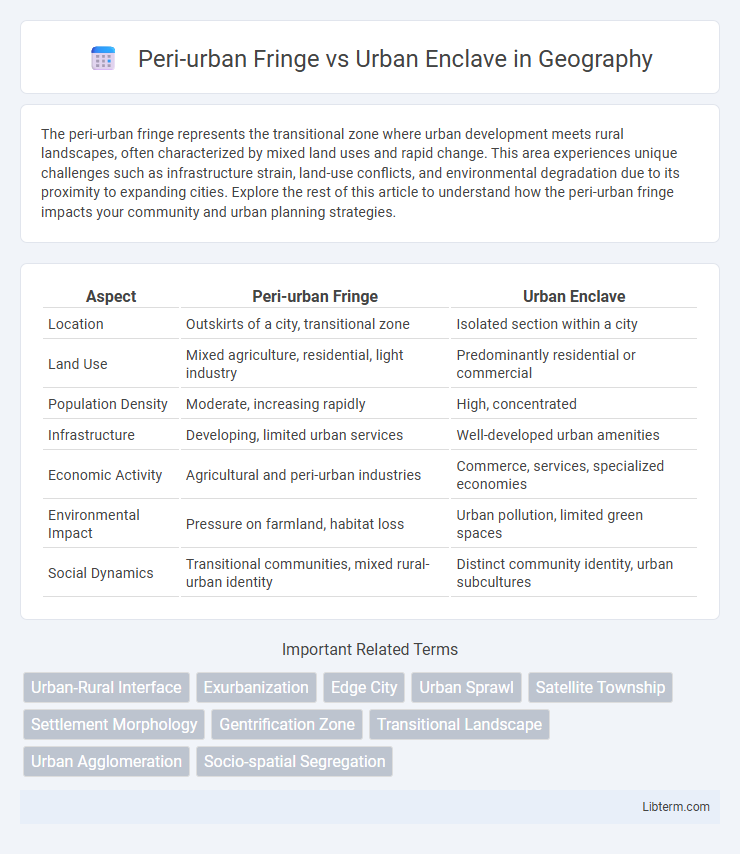The peri-urban fringe represents the transitional zone where urban development meets rural landscapes, often characterized by mixed land uses and rapid change. This area experiences unique challenges such as infrastructure strain, land-use conflicts, and environmental degradation due to its proximity to expanding cities. Explore the rest of this article to understand how the peri-urban fringe impacts your community and urban planning strategies.
Table of Comparison
| Aspect | Peri-urban Fringe | Urban Enclave |
|---|---|---|
| Location | Outskirts of a city, transitional zone | Isolated section within a city |
| Land Use | Mixed agriculture, residential, light industry | Predominantly residential or commercial |
| Population Density | Moderate, increasing rapidly | High, concentrated |
| Infrastructure | Developing, limited urban services | Well-developed urban amenities |
| Economic Activity | Agricultural and peri-urban industries | Commerce, services, specialized economies |
| Environmental Impact | Pressure on farmland, habitat loss | Urban pollution, limited green spaces |
| Social Dynamics | Transitional communities, mixed rural-urban identity | Distinct community identity, urban subcultures |
Defining Peri-Urban Fringes and Urban Enclaves
Peri-urban fringes refer to transitional zones between rural and urban areas characterized by mixed land uses, rapid population growth, and evolving infrastructure that blends agricultural and urban features. Urban enclaves are distinct, often socio-economically homogeneous pockets within a larger urban area, marked by concentrated cultural, ethnic, or economic identities that create spatial separation from surrounding neighborhoods. Understanding these definitions highlights the contrast between dynamic, expanding peri-urban zones and the socially defined, localized nature of urban enclaves.
Historical Evolution of Urban Boundaries
The historical evolution of urban boundaries reveals that peri-urban fringes emerged as transitional zones where rural landscapes gradually transform into suburban developments due to city expansion, often marked by fragmented land use and informal settlements. In contrast, urban enclaves originated as deliberately planned, enclosed districts within cities, often defined by socio-economic or ethnic homogeneity, maintaining distinct spatial and functional identities over time. These differing patterns in boundary evolution reflect varying urban growth dynamics, governance policies, and socio-cultural factors shaping city morphology.
Key Characteristics of Peri-Urban Fringes
Peri-urban fringes are transitional zones between rural and urban areas, characterized by mixed land uses, rapid population growth, and fragmented infrastructure. These areas often exhibit lower population density compared to urban centers, with a blend of agriculture, residential, and industrial activities. Unlike urban enclaves, peri-urban fringes face challenges related to unplanned development, limited access to public services, and environmental degradation.
Unique Features of Urban Enclaves
Urban enclaves are distinct urban areas characterized by concentrated populations sharing a common cultural, ethnic, or social identity, often preserving unique traditions and social networks within a metropolitan context. These enclaves typically feature specialized businesses, religious institutions, and community centers that foster strong intra-group cohesion and economic support systems. Unlike peri-urban fringes, which are transitional zones between rural and urban areas marked by mixed land use and development pressures, urban enclaves maintain a distinct cultural landscape amid the broader urban environment.
Socioeconomic Dynamics: Fringe vs Enclave
Peri-urban fringes often exhibit heterogeneous socioeconomic dynamics characterized by rapid urbanization, diverse income groups, and mixed land uses, fostering both formal and informal economic activities. In contrast, urban enclaves are typically marked by socioeconomic homogeneity, with concentrated wealth or poverty, leading to spatial segregation and limited social mobility. The peri-urban fringe's dynamic interface between rural and urban economies contrasts sharply with the enclosed, often insular socioeconomic patterns within urban enclaves.
Land Use Patterns and Urban Development
Peri-urban fringe areas exhibit mixed land use patterns characterized by a blend of agricultural activities, low-density residential zones, and emerging industrial developments, reflecting transitional urban expansion. Urban enclaves typically feature high-density residential, commercial, and institutional land uses concentrated within city limits, fostering intensive urban development and infrastructure. The peri-urban fringe acts as a dynamic buffer facilitating suburbanization and spatial growth, while urban enclaves represent established cores with limited land availability and advanced urban services.
Infrastructure and Service Delivery Challenges
Peri-urban fringes face inadequate infrastructure due to rapid, unplanned expansion, resulting in limited access to essential services such as water, sanitation, and electricity. Urban enclaves often benefit from better-developed infrastructure but encounter challenges related to service delivery efficiency and equitable resource distribution within densely populated areas. Both environments struggle with coordinating infrastructural development and service provision to accommodate growing populations and evolving urban dynamics.
Environmental Impacts and Sustainability Issues
Peri-urban fringes often experience significant environmental degradation due to rapid land-use changes, loss of agricultural land, and increased pollution from expanding urban sprawl, challenging sustainable resource management. Urban enclaves, while more contained, contribute to environmental stress through high-density development, intensified air and noise pollution, and limited green spaces, impacting local biodiversity and residents' quality of life. Sustainable urban planning must address both peri-urban and urban enclave dynamics by incorporating green infrastructure, efficient public transportation, and policies that mitigate fragmentation and promote ecosystem services.
Policy Approaches for Fringe and Enclave Management
Policy approaches for managing peri-urban fringes emphasize sustainable land use planning, integrating green belts, and controlled urban expansion to balance development and environmental conservation. Urban enclave management prioritizes zoning regulations, infrastructure provision, and social inclusion policies to ensure equitable access to services and mitigate spatial segregation. Effective governance frameworks involve multi-level coordination and community participation to address the distinct challenges of both peri-urban fringes and urban enclaves.
Future Trends: Urban Expansion and Integration
Peri-urban fringes are expected to experience significant urban expansion due to population growth and infrastructure development, leading to increased land use changes and mixed land functions. Urban enclaves will focus on greater socio-economic integration through smart city technologies, enhancing connectivity and sustainable resource management. Future trends suggest a convergence where peri-urban areas gradually adopt urban enclave characteristics, fostering seamless metropolitan integration.
Peri-urban Fringe Infographic

 libterm.com
libterm.com